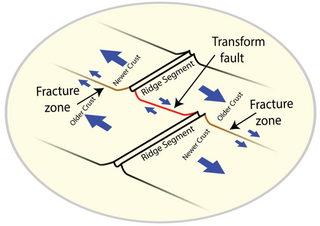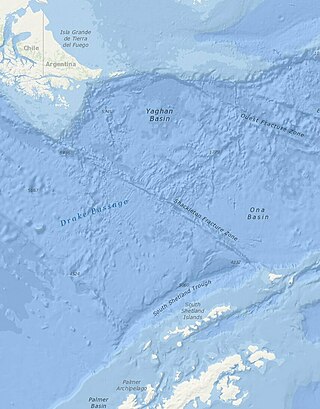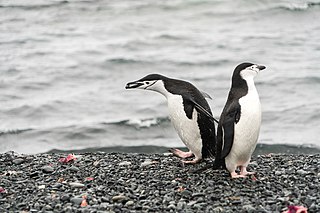
A fracture zone is a linear feature on the ocean floor—often hundreds, even thousands of kilometers long—resulting from the action of offset mid-ocean ridge axis segments. They are a consequence of plate tectonics. Lithospheric plates on either side of an active transform fault move in opposite directions; here, strike-slip activity occurs. Fracture zones extend past the transform faults, away from the ridge axis; are usually seismically inactive, although they can display evidence of transform fault activity, primarily in the different ages of the crust on opposite sides of the zone.

The Shackleton Fracture Zone (SFZ) is an undersea fracture zone, mid-oceanic ridge and fault located in the Drake Passage, at the separation between the Scotia plate from the Antarctic plate. It extends between 59° and 60°40' south latitude and between 56°30' and 61° west longitude and runs in a northwest to southeast direction from the South American continental shelf to the South Shetland Islands. Chile claims the area as part of its Outer Continental Shelf boundary.
Endurance Ridge is an Antarctic undersea ridge, south-east of Coronation Island in the South Atlantic Ocean. It was named after the Endurance Expedition of 1914–1917, and its name was approved by the Advisory Committee for Undersea Features in June 1987.
Astrid Ridge is an undersea ridge on the continental margin of Dronning Maud Land, East Antarctica. It is present on the GEBCO 5th edition charts. The name was approved by the Advisory Committee for Undersea Features in June 1987.
The Antipodes fracture zone is an undersea fracture zone named in association with Antipodes Island. The name was proposed by Dr. Steven C. Cande of the Scripps Institution of Oceanography, and approved by the Advisory Committee on Undersea Features in September 1997.
Balleny Fracture Zone is a fracture zone in the Southern Ocean that extends south towards the Balleny Islands. The name was approved by the Advisory Committee for Undersea Features in December 1971.
Kosminskaya Fracture Zone is an undersea fracture zone named for Professor Irina Kosminskaya, a Russian scientist specializing in Marine Geophysics and Seismology. The name was proposed by Dr. Galina Agapova of the Geological Institute of the Russian Academy of Sciences, and was approved by the Advisory Committee on Undersea Features in September 1997.
Vinogradov Fracture Zone is an Antarctic undersea fracture zone named for Alexandr Vinogradov, a Russian scientist/geochemist and first Director of the Vernadsky Institute of Geochemistry (GEOKHI). The name was proposed by Dr. Galina Agapova of the Geological Institute of the Russian Academy of Sciences, and was approved in September 1997.
Pitman fracture zone is an undersea fracture zone named for Dr. Walter C. Pitman III, a geophysicist and pioneer in studies of continental drift and seafloor spreading. Name proposed by Drs. Cande, Haxby and Raymond, Lamont–Doherty Geological Observatory ; name approved 3/93.

Paré Glacier is a glacier 7 nautical miles (13 km) long and 1 nautical mile (1.9 km) wide, draining the northeast slopes of Stribog Mountains, and flowing east and then northeast into the head of Bouquet Bay on the northeast side of Brabant Island in the Palmer Archipelago, Antarctica.

Dunlop Island is a rocky island, one nautical mile (2 km) long, lying just off the Wilson Piedmont Glacier and the coast of Victoria Land, close northeast of Cape Dunlop. It was first mapped by the British Antarctic Expedition, 1907–09, under Ernest Shackleton, who named it for H.J.L. Dunlop, chief engineer of the ship Nimrod.
The Emerald Fracture Zone is an undersea fracture zone running the distance from the southwest corner of the Campbell Plateau to the northern tip of Iselin Bank. The name was proposed by Dr. Steven C. Cande of the Scripps Institution of Oceanography for the vessel Emerald, which traversed this region in 1821, and was approved by the Advisory Committee for Undersea Features in June 1997. The Emerald Basin to its north west was named from the same source. Some have restricted the name to the southern east west orientated transform fault zone but the north south orientated faults that define the eastern boundary of the Emerald Basin are generally included in the literature.

Cape Garry is a cape forming the south-western extremity of Low Island in the South Shetland Islands of Antarctica. It was charted and named by a British expedition under Henry Foster, 1828–31, and was more accurately mapped by the Falkland Islands Dependencies Survey in 1959 from aerial photographs taken by the Falkland Islands and Dependencies Aerial Survey Expedition, 1955–57.
Hakurei Seamount is a seamount located off Adélie Land, Antarctica. The name, approved by the Advisory Committee for Undersea Features in July 1999, is for the RV Hakurei-maru which conducted a detailed survey of the area.
The Heirtzler fracture zone is an undersea fracture zone located south of New Zealand, near Antarctica.
The Hero Fracture Zone is an undersea fracture zone in the Antarctic. Its name was approved by the Advisory Committee on Undersea Features in June 1987.
Vaughan Seamount, formerly Vaughan Bank, is a seamount and submarine bank in the Balleny Islands area. It was named for V. J. Vaughan, Commanding Officer, USS Glacier used in the U.S./New Zealand Balleny Island Expedition (1965). Name approved 4/80.
Ross Canyon is an undersea canyon named in association with Ross Sea. Name approved 6/88.
Ligeti Ridge is an undersea ridge in the Southern Ocean. The name was approved by the Advisory Committee for Undersea Features in June 1987.
The Hjort Trench is a linear topographic depression south of Macquarie Island in the southwest Pacific Ocean. Geologically, the depression is considered to be the seafloor expression of an ocean-ocean subduction zone, where the Australian plate is thrusting beneath the Pacific plate. As the southernmost portion of the Macquarie Ridge complex, the Hjort Trench lies in an area of diagonal convergence produced by the transform fault evolution of the Emerald Fracture Zone. Frequent seismic events, most less than 20 km (12 mi) deep, characterize the transpression along this plate boundary.




